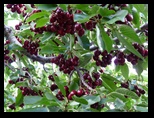


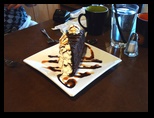
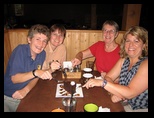
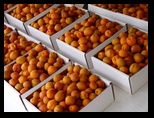
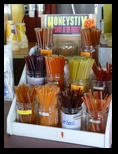

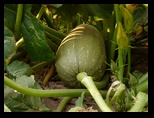
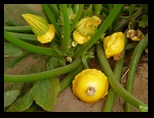
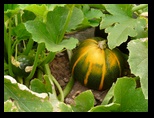
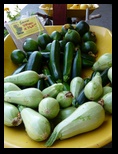
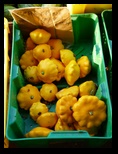
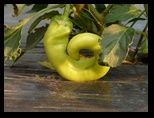
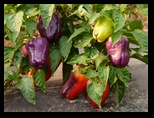
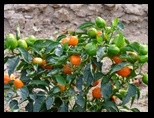

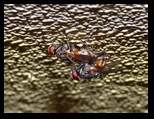
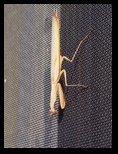
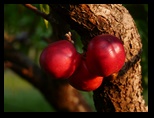
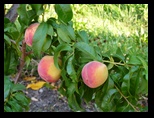
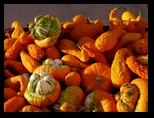

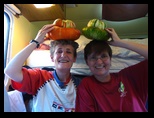
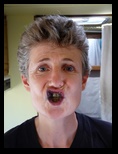

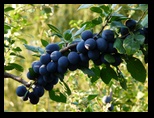
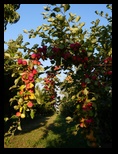


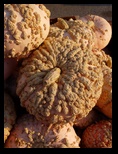
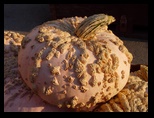
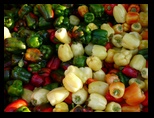

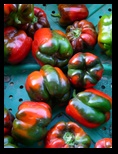

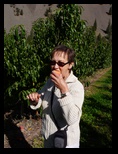
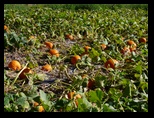
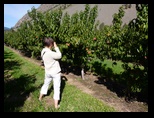

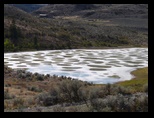
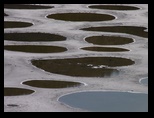
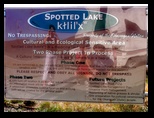
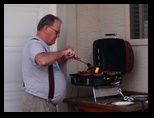
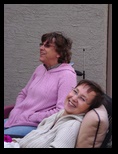
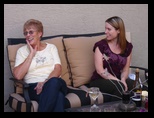

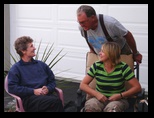
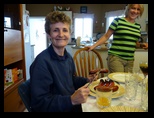

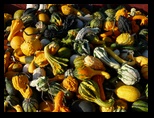
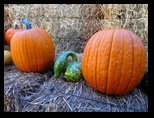

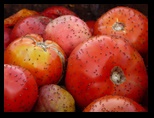
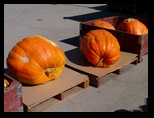
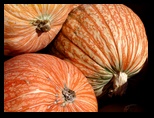
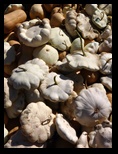
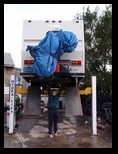
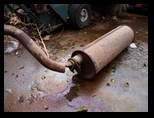
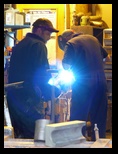
Click on a photo to enlarge it.
We spent the whole summer in the Okanagan Valley which is well known as a fruit and vegetable growing area. We were amazed at how much is actually grown in this one
valley and the variety is quite unbelievable.
These days you can go into a supermarket and buy fruit and veg the whole year round and most people don't know anymore, when everything is actually in season.
We arrived at the beginning of the cherry season and left at the end of the pumpkin and squash season and there was a great deal in between. We have certainly learned
a lot and seen various fruit and veg we have never seen before and we have found out how much better the fresh produce tastes when you buy it direct from the grower
where it grows. It is also a lot cheaper!!
So, what have we learned?
Well, a cherry isn't just a cherry! There are at least 12 different varieties that grow just in this valley. Some are sweeter than others and the size of the cherry
varies. Also the stems are different and you can learn how to distinguish between each sort just by looking at the stems. The freshest cherries have green stems but
those that are already brown have spent a week or two in a cooler somewhere. If the stem is already dried out then you don't want to buy it!
Apricots, nectarines, peaches, plums and pears are grown here and picked when they are unripe. Unlike cherries these fruits continue to ripen but if they are picked
when they are ripe they will bruise before they get into the fruit stands. So you basically buy unripe fruit and leave them to ripen at home for anything from a few
days to two weeks!
The fruit and veg here taste absolutely wonderful and soooo juicy. Our favourite apricots were called Pui-sau-sin, and grow on 40 year old trees. They don't look the
best and are quite pale in comparison to newer varieties but they are the juiciest and taste the best.
Unfortunately, it seems that everyone wants fruit and veg to look perfect but that means they are probably genetically modified and have no taste. We need to
concentrate on the old varieties that taste the best but don't necessarily look perfect - the pui-sau-sin apricots are one example another are what was called
"ugly green plums" … boy, do they taste good!!!!
The zucchinis growing here are also different varieties. We are used to the smaller versions (courgettes) but if you leave them to grow they will continue doing just
that and end up weighing 10 lbs each! You could buy 3 monster zucchinis for just one dollar!! There were also Lebanese (pale green) and eight ball (round) zucchinis.
A lot of peppers are grown here (paprika) and in different colours - including blue, brown and black which are a version of the green pepper and turn green when
cooked. A multitude of hot peppers are grown and range from the not so hot (but still hot for us) to the mega hot Tepins. These take 2.5 months to ripen and are really
small, about 2mm in diameter. They are sold at 10 cents each because they don't weigh anything but are said to be the hottest and can kill if too many are used!! Some
like it hot!
With so much variety we tried out different things. We made fresh salsa using fresh roma tomatoes and fresh garlic (we will never buy garlic in a supermarket again!)
and we even made our own samosas which were better than those from an Indian restaurant! But then we had to have ice cream to cool us down and Helen tried one that was
blue and ended up with blue lips and tongue. This reminded us of the Maoris and so Helen did a little Maori dance (see video below).
Helen´s Maori performance.
We got a great recipe from Rosemary - peppers filled with cheese and wrapped in bacon, put in oven for 45 minutes and Voila!! Wonderful. Of course we also made cherry,
apricot, peach and plum cake or crumbles with cream and made our own apple sauce.
Later in September and October there was cabbage, turnips, swede and pumpkin on the menu. We tried some of the varieties of squash but we are not really squash fans.
The area is also known for its honey and there are numerous types and varieties. Did you know that each colony of honeybees contains one queen, several hundred drones
or male bees and about 60,000 worker bees or undeveloped females? The queen lays up to 1,500 eggs per day in the summer. The drones function is to mate with the queen
and the worker bees, which live about 6 weeks, care for the queen, develop the larvae, build honeycombs, maintain the temperature and humidity inside the hive and
gather pollen and nectar to produce honey.
During its 6 weeks lifetime, a worker bee flies the equivalent distance of once around the world and produces only one teaspoon of honey!
We also had a lot of visits from friends we have got to know since we have been travelling in our motor home including Joyce and Christine (mother and daughter) who we
know from Teacapan. They came for one night and we went out for a wonderful meal together. Edi and Jochen came with their nephew Rene who was on his first trip away
from home. Also Brian and Lily visited on their way from Vancouver inland to visit their daughter.
Kirsten's mother came over to Canada to visit long time friends, Heide and Dieter, who emigrated from Germany to Canada in 1975. We stayed with Heide and Dieter in
2005 and met two of their three daughters, Kirsten and Ilka, when we were there.
Kirsten's mom flew to Saskatchewan and then Heide and her other daughter Ines drove about 900 miles all the way over to see us in the Okanagan Valley. They stayed with
friends in Oliver for the night and then drove over to see us. Kirsten's mom stayed with us in the motor home for the night. There was a lot to catch up on. Kirsten's
parents had just been on a cruise in the Baltic Sea and went to Helsinki and St Petersburg. This was Kirsten's mom's first trip to Canada.
The next day we drove over to Oliver and spent a great evening with everyone. On the next day Heide, Ines and Mutti drove all the way back to Saskatchewan - a lot of
driving just so we could see them for which we are very grateful.
A few days later Ilka came by along with her husband and dog and we chatted for a few hours. They were on their way for a few nights holiday and stopped by on their
way back to Vancouver as well.
Summer went by very quickly and all of a sudden the temperature dropped. It had been very hot at times - around 36°C to 38°C was not unusual. But over the Thanksgiving
weekend (Oct 12th) the temperature dropped down to minus 7°C!! This broke a 60 year record!
Fortunately we had electricity and could put our heater on but we were still cold. The pumpkins and apples froze and so did we! It was time to head south.
But first we had to get some repairs done as we have to get through a smog test in California by the beginning of November and we had several problems that needed
fixing otherwise we would fail the test.
We needed a new front seal and an oil change and found out that our exhaust pipe had a huge hole in it! We also had a hairline fracture in the header pipe (front
exhaust). We would have failed the smog test with our exhaust problems.
So we got all that fixed at the local garage that had been recommended. They were very good. But they couldn't get a second hand header pipe and ended up welding the
original (see video).
Welding the exhaust pipe.
They also soldered our radiator so that the hose would stay clamped on and stop us from continually having to fill up with coolant and used foam
and sealant behind the back wheels where stones had damaged the aluminium base.
So now we are ready to head south into the unknown!